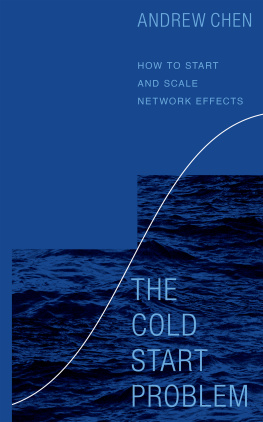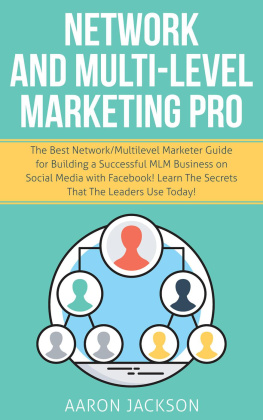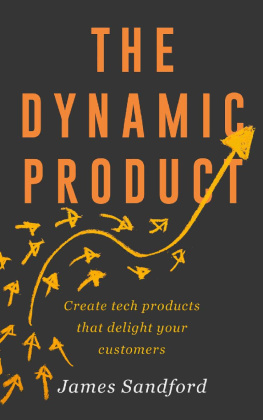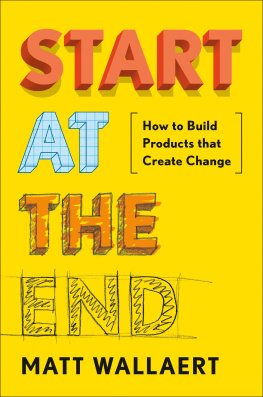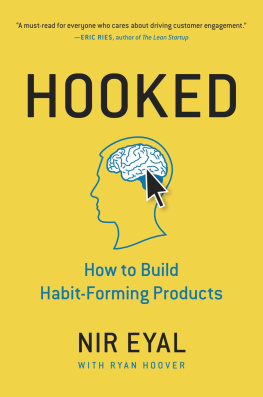Contents
Guide
THE COLD START PROBLEM . Copyright 2021 by Andrew Chen. All rights reserved under International and Pan-American Copyright Conventions. By payment of the required fees, you have been granted the nonexclusive, nontransferable right to access and read the text of this e-book on-screen. No part of this text may be reproduced, transmitted, downloaded, decompiled, reverse-engineered, or stored in or introduced into any information storage and retrieval system, in any form or by any means, whether electronic or mechanical, now known or hereafter invented, without the express written permission of HarperCollins e-books.
Illustrations by Andrew Chen
Graphs by Greg Truesdell
FIRST EDITION
Digital Edition DECEMBER 2021 ISBN: 978-0-06-296975-0
Version 10212021
Print ISBN: 978-0-06-296974-3
Contents
I t was a Friday evening in December 2015, and the office was buzzing. Amid the vast, monochromatic corridors of Ubers San Francisco headquarters at 1455 Market Streettwo football fields worth of gleaming LED lights, light woods, concrete, and steelthe office was still mostly occupied at 8 p.m. Some sat at their desks quietly typing emails while others debated energetically with colleagues over videoconference. Others were drawing on whiteboards, hosting impromptu jam sessions to tackle the tricky operational problems facing who-knows-what. And a few pairs of employees were walking up and down the main flow in one-on-one meetings, some in intense discussion and others just catching up.
Everywhere you looked, there were reminders of the global scale of Ubers business as well as the international heritage of the team driving it. Colorful flags from every country hung from the ceiling. Conference room screens hosted videoconferences with colleagues from faraway offices in Jakarta, So Paulo, and Dubaisometimes simultaneously! Flat-screen TVs were scattered throughout the floor showing metrics, broken down by mega-region, country, and city, so that teams could monitor progress. The global culture seeped into the naming conventions for conference rooms: near the entrance, the names started with Abu Dhabi and Amsterdam, and at the far other end of the floor, they ended with Vienna, Washington, and Zurich.
At first glance Uber might just look like a simple appafter all, the premise was always to hit a button and get a ride. But underneath its deceptively basic user interface was a complex, global operation required to sustain the business. The app sat on a vast worldwide network of smaller networks, each one representing cities and countries. Each of these networks had to be started, scaled, and defended against competitors, at all hours of the day.
It was in my role at Uber that I really came to viscerally understand networks, supply and demand, network effects, and their immense power to shape the industry. As you might imagine, the Uber experience had its ups and downsit was a rocketship and a roller coaster, rolled into one. Ive come to call it a rocketcoaster experience, which is an appropriate description for a company that had gone from an idea to a tiny startup to a massive global company with more than 20,000 employees in less than a decade.
The worldwide operations of the company were complex and intense, and much of the command and control radiated from the center of Ubers San Francisco headquarters. In the middle of the main floor, built from gleaming surfaces of glass and metal, stood the War Room.
To many, it was a big mysterythe War Room didnt share the normal naming convention of city names where Uber operated. It couldnt be booked for meetings as the others could, and was sometimes attended to by security guards. Thats because it wasnt a normal meeting room. Many companies (inside and outside tech) have the notion of war rooms. But, they are typically conference rooms converted temporarily to dedicated use by a product team, working intensely to tackle an emergency product. After the situation is resolved, the room is quickly converted back to normal use. For Uber, perhaps appropriate to its unique needs, this War Room was not temporary at allit was built to operate twenty-four hours, around the clock. It was built as a huge, permanent room with dark wood walls, multiple flat-screen TVs, a large conference table that could fit a dozen people, and additional sofa seating. Red digital clocks gave the current times in Singapore, Dubai, London, New York, and San Francisco. Given the companys global footprint, there was almost always some kind of emergency situation somewhere in the world that needed attention, and this was often the room where it was dealt with.
That December, the emergency was in San Francisco, the companys hometown.
Scheduled to start at 7 p.m. and run into the night, the urgent meeting was booked on everyones calendar as NACS, which stood for the North American Championship Series, an oblique reference to its agenda focusing on operations, product road map, and competitive strategy in the top markets in the United States and Canada. This meeting was a key mechanism for the CEO of Uber, Travis Kalanickcalled TK within the companyto review the entire business, city by city.
A small group of about a dozen executives and leaders attended the meeting, including myself and the heads of finance, product, and critically, the RGMsshort for Regional General Managers. The RGMs ran the largest teams at Uber, constituting the on-the-ground Operations city teams that engaged with drivers and riders. The RGMs were thought of as the CEOs of their markets, holding responsibility for revenues and losses, the efforts of thousands of Ops folks, and were always closest to the trickiest problems in the business. I was there to represent the Driver Growth Teama critical team responsible for recruiting the scarcest asset in the entire business, Uber drivers. It was a big effort for Uberwe spent hundreds of millions just on driver referrals programs, and nearly a billion in paid marketing. Adding more drivers to the Uber network was one of the most important levers we had to grow the business.
The weekly NACS meeting opened with a familiar slide: a grid of cities and their key metricstracking the top two dozen markets. Each row represented a different city, with columns for revenue, total trips, and their week-over-week change. It also included operational ratios like the percentage of trips that hit surge pricing, where riders had to pay extra because there werent enough drivers. Too much surge, and riders would switch to competitors. Ubers largest markets, New York, Los Angeles, and San Francisco, were always near the top of the list, representing billions of annual gross revenue each, with smaller cities like San Diego and Phoenix near the bottom.
TK sat closest to the screen, dressed casually in a gray T-shirt, jeans, and red sneakers. At the sight of the numbers, he sprung up from his chair and walked up close to the screen. He squinted, staring intensely at the numbers. Okay, okay... he said, pausing. So why did surge increase in San Francisco so much? And why is it up even more in LA? He began to pace up and down the side of the War Room, the intensity of the questions increasing. Have we seen referral sign-ups dip in the last week? Hows the conversion rate in the funnel going? Were there big events this week? Concerts? Folks in the room began to chime in, answering questions and raising their own.
A Network of Networks
It was my first year at the company, and although many companies have weekly reviews, Ubers were different. First, in the discussion about each city, the level of detail surprised me. For San Francisco, the group began to discuss the surge percentages in the citys seven-mile by seven-mile center, versus East Bay, versus the Peninsula. This was a senior group of executives, but the granularity and level of detail was incredible. But this was a requirement to run a complex, hyperlocal network like Uber where supply and demand depended on the dynamics of popular neighborhoods and frequent laneslike Marina and the Financial Districtthat tended to be poorly served by other transportation options.

